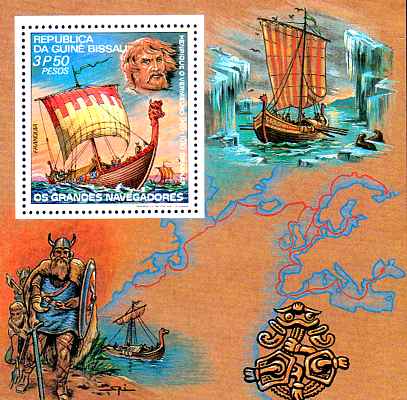
Erik the Red with his boat in Greenland ice; below the routes of
the Vikings’ travels.
|
Maritime Topics On Stamps
Erik the Red
and
his son Leif!
|
|
This site reports of the Atlantic voyages of the Vikings to the Faeroe
Islands, Iceland, Greenland, and Newfoundland. Led by Erik the Red and later on
by his son Leif Eriksson, the Vikings sailed to unknown coasts, explored them and even settled there!
|
The Viking conquests and raids were limited to the coasts of Europe. Their first travels across the Atlantic were due
to other reasons. Their every day lives faced homicides, blood feuds, and deadly challenges. On the other hand
they followed strict and fair laws administered by a judicial assembly calle the Thing. A frequently imposed
punishment was banishing. The guilty were forced to leave the country. So they sailed to and settled in the Faeroe Islands,
Iceland and Greenland.
This was followed by commercial voyages between these islands and Northern Europe.
|
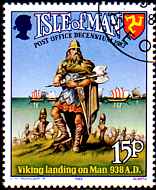
|
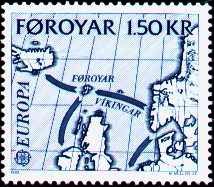
|
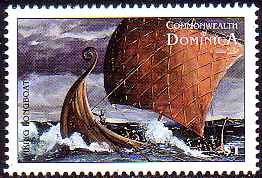
|
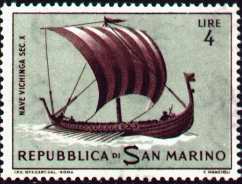
|
The Vikings crossed the Atlantic with the longship, seen on stamp at
left. The boats had 40 to 60 oars. Their length amounted to around 100 ft, width 20 ft, draft 3 ft. Masts were approx.
30 ft high, the sail had a span up to 50 ft.
These ships could reach 11 knots under sails, Norwegian sources even speak of 20 knots!
The shallow draft permitted entering rivers and coastal estuaries with little depth; boats were easily pulled up
onto dry land and rolled forward on tree-trunks.
Left above we see their routes, next to it a boat in an Atlantic storm.
|
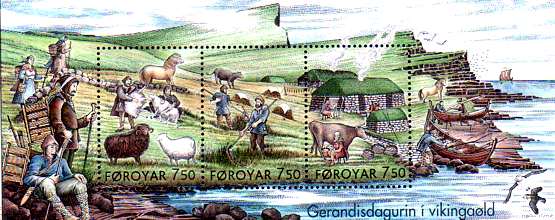
| |
The banished Vikings and their families founded settlements as seen on these stamps, engaging in agriculture and
cattle breeding. In addition there was fishing and transatlantic trade.
|
How did the Vikings navigate across the Atlantic?
The Viking "Raven Floki" owed his name to the fact of carrying three ravens aboard his ship while searching
for the vaguely described Iceland. One day after leaving the Faeroes he released the first raven and the bird flew
back towards the Faeroes. On the second day he let the second raven fly off and the bird moved upwards
but then returned to the ship. When on the third day he released the last raven, the
bird flew towards the northwest; Floki followed in this direction and so reached Iceland.
|
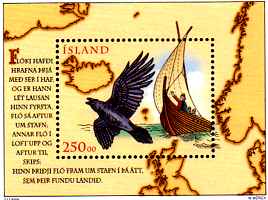
|
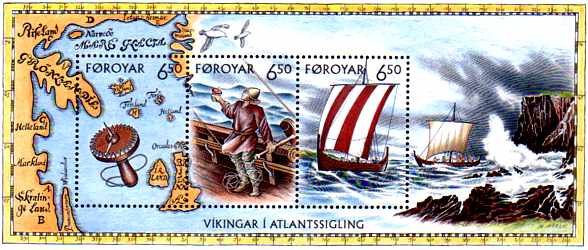
|
The azimuth dial determined the directions to sunset (west)
or sunrise (east) and was marked with a pointer.
needle. The sun shadow board consisted of a pane with a pin in its center surrounded by concentric circles.
The pin was adjustable and cast a shadow on the pane.
The length of this shadow was used to determine latitude and to set the course accordingly.
The sun stone was a Cordierit silicate. Held in an right angle to the sun, the usually yellow crystal changed its colour
to dark blue. Amazingly, this also worked in fog or overcast skies. All the Viking had to do to locate the sun
was turning the stone until it went blue.
|
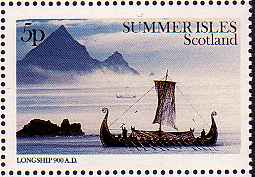
|
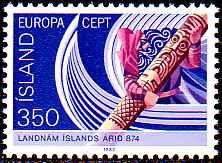
|
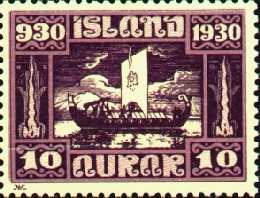
|
The settling of Iceland started with the Viking Ingolf Arnarson in 874.
On the stamps we see his boat. On the foredeck his men are throwing the posts of his high chair overboard.
Such was the custom: Where they drifted ashore, that’s where the Viking settled. It was at the 'smoking bay', Reykjavik.
About 150 years later the population amounted to some 60,000 humans living in Iceland.
|
|
Erik the Red (Erikur Raudi) lived from approx. 950 to 1003. He was born
in Norway as Erikur Thorvaldsson. In 970 his father had to leave the homeland because he had committed murder.
So he joined the Viking colony on Iceland.
Eri, the Red was named after his red hair and a red beard and because "blood
stuck to his hands". His wife Tjodhild is quoted to have said about him: “His
pride almost cost him his life. In addition, he has diligence and perseverance. As a warrior I do not know a better one.
He is affectionate towards me and he can cultivate a farm very well.”
|
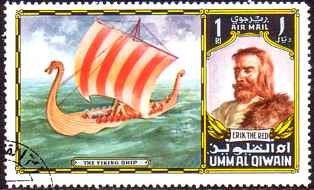
|
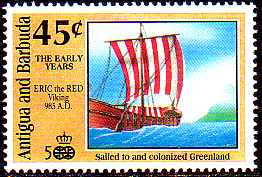
|
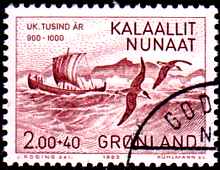
| |
Erik loved to fight and solved problems his own way. During a dispute regarding pasture lands he killed two of his
neighbours. He was condemned to three years "without peace", i.e. sent into banishing.
In 875 Gummbjoern Ulfsson had discovered land towards the west of Iceland. It was of no interest to him as all he saw
was ice floes, fog, and snow-covered mountains. The Icelanders named these lands ‘Gumbjoernschaere’.
During 982 the banished Erik accompanied by 32 comrades sailed to this country.
There he explored the coasts and discovered green valleys, caribou, bears, seals, and rivers filled with fish.
He named this country ‘Greenland’ (see stamp at left) to encourage other Icelanders to settle there.
|

|
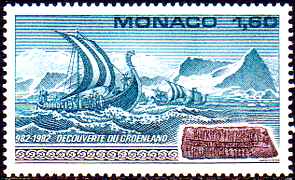
| |
After three years of banishment had passed, Erik the Red returned to
Iceland. There he recruited for his "green land", convincing many families as pastureland was scarce on Iceland.
Monaco’s stamp issued in 1982 commemorated the 1000th Anniversary of Erik the Red’s discovery of Greenland.
|
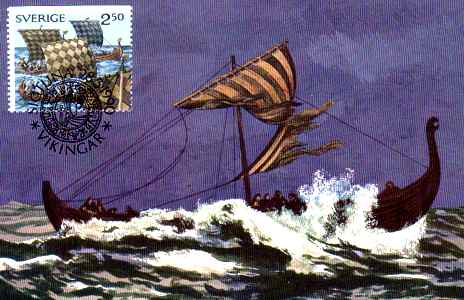
| |
In 985 Erik sailed sailed to Greenland with 25 ships. They encountered several strong storms and collided
with icebergs. Breaking waves washed settlers overboard. Only 14 ships with approx. 700 persons arrived.
|

|
They founded two settlements, Austbygd and Vestbygd. Erik built his farm Brattahild in Austbygd.
On the stamps we see from left to right a Viking boat, a man with urgently needed drift wood, an arrowhead and
coins, and the church of Tjodhildes, Eriks wife’s. The foundation walls of this church can still be seen today.
During the 9th century missionaries were winning converts in northern Europe but Erik the Red remained faithful to
his northern gods all his life. However, his wife and children became Christians. They even had a bishop during the
Viking colony’s golden age on Greenland.
More newcomers arrived and soon the population had reached 3000 people. They engaged in lively trade with Iceland
and Europe: Furs and walrus teeth in exchange for grain, iron and salt. Greenland’s climate was not appropriate to
cultivate grains. In 1002 the colony suffered a large epidemic. Disease claimed many lives,
Erik the Red’s among them in 1003.
|
Erik the Red had four children. His second son Leif Eriksson was born
around 970. His death is given at approx. 1020. He was probably the first European to step on North American soil.
There are reports that unknown Icelanders had already reached North America by 985.
Also, the Greenland saga credits Bjarni Herjolfsson as discoverer of the American continent. He intended to sail
from Iceland to Greenland but storms blew him off course, supposedly in 986. Bjarni Herlufsson is said to have observed
flat shores with small hills and endless forests without ice and glaciers.
|
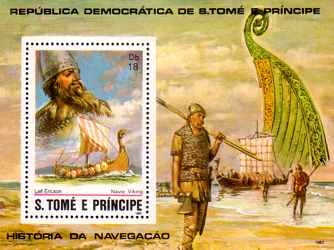
|
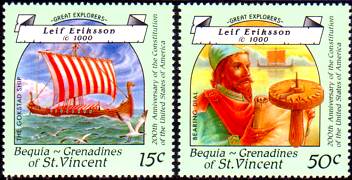
|
Leif Eriksson's landfall in North America in the year 1000 (or 1001) is
reported by Adam of Bremen in a manuscript written in 1076, regarded believable by many scholars.
There is also a possible reason for Leif wanting to find this land: He is said to have bought Bjarni's ship, then set sail on a southwesterly course, with 36 men.
| |
His father Erik the Red intended to accompany him but then he
fell from a horse and hurt his leg.
Considering this a bad omen he remained at home.
First, Leif reached Labrador which he called "stoneland". Next he came to Newfoundland and called it "woodland".
|
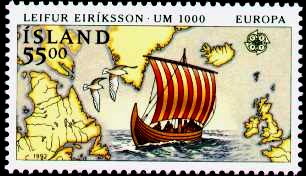
|
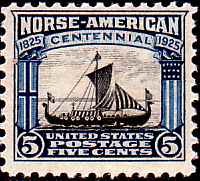
|
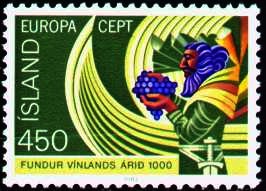
|
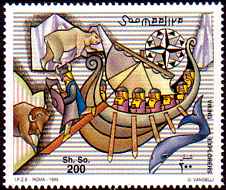
|
Afterwards he sailed along the coast and probably made it to the area at Cap Cod near Boston. There the Vikings
found rich pastures, large forests, and rivers teeming with fish. They went ashore and called this country "Vinland",
the landing place received the name "Leifsbudir". Here the Vikings founded a settlement in later years.
Until today the exact location of ‘Vinland’ is still shrouded in mystery. "Vin" can mean ‘wine’ with emphasis on the "i",
however without such emphasis it denotes ‘pasture’. Only wild berries but no grapes are growing in these
northern latitudes, consequently this "Vinland" is interpreted as pastureland today.
|
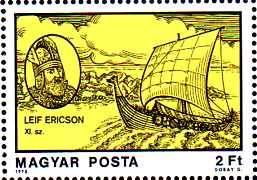
|
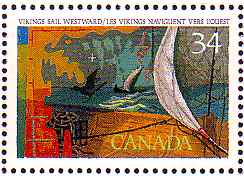
|
Leif's brother Thorwald also sailed to Vinland and settled there, other Vikings followed. Eventually, Vikings created
several settlements in Newfoundland. (In 1961 a settlement was excavated and eventually declared a World
Cultural Heritage site.)
Contacts with the natives were peaceful at first. But soon bloody fights erupted.
Thorwald died in a hail of arrows.
In 1009 the Viking Karlsefnis settled in Vinland. He was married to Erik the Red’s daughter Freydis.
He had to prevail in violent fights with the natives, even Freydis swung the
sword and frightened the natives! They called the natives "Skraelinge" (cowards, weaklings).
Nevertheless, these settlements had to be abandoned.
|
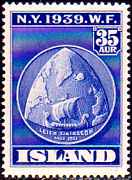
|
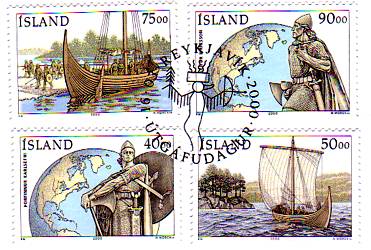
| |
For many years, an extensive trade was carried on between the Viking settlements in Greenland and North America.
America provided the important materials such as timber, skins, furs, and animal fats. These relations continued
until well into the 14th century. Then the Vikings disappeared from both regions. What exactly happened, nobody knows.
|
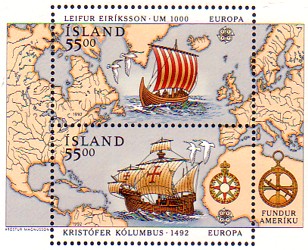
| For Europeans, Columbus had to discover America all over again in 1492!
|
| Leif Eriksson Day 1938, with his monument in Reykjavik.
|
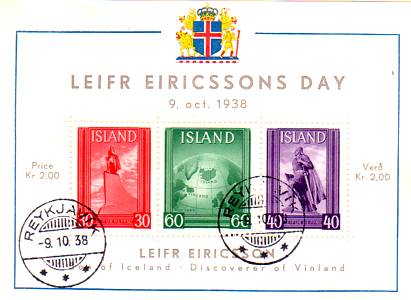
|
| Source:
Wikipedia Internet Encyclopaedia
|
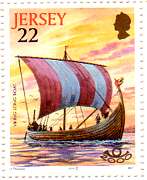
|
|